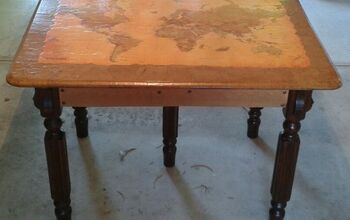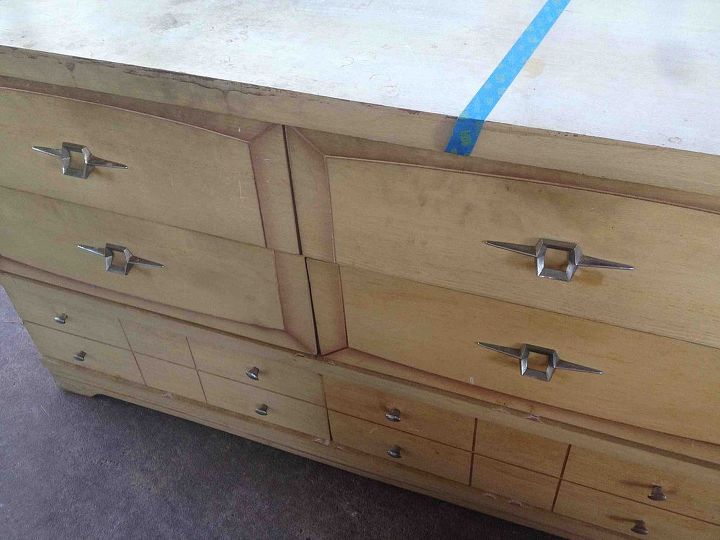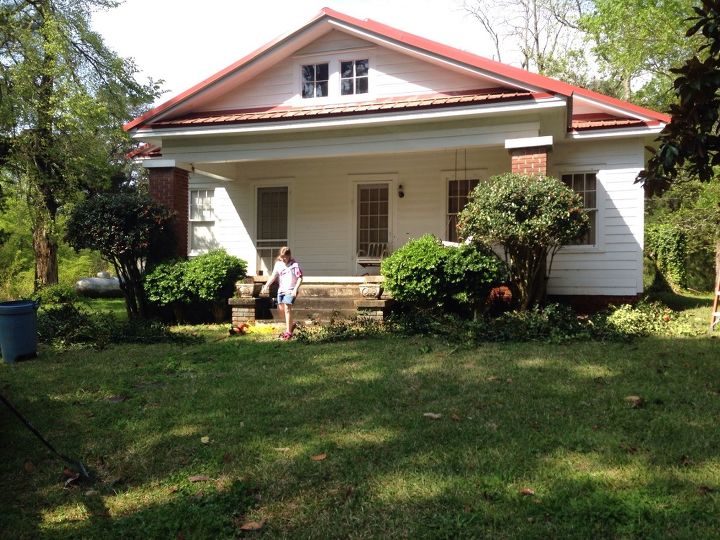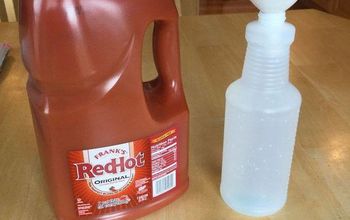How do I best fill the holes in the top of this marvelous old table?

-
Plug your holes with dowel rods. Buy a size that fits snug in the holes, even if tamping the down with a hammer is required and glue with wood glue. Just be sure and wipe any excess wood glue off the table after tamping them down. Think I would rather see the wood circles than wood filler. On the edge you may have to do some hand sanding to make the ridge, but it will be well worth the time and effort.
 Donna Byram
on May 10, 2014
Helpful Reply
Donna Byram
on May 10, 2014
Helpful Reply -
-
Determine what kind of wood is the table top, then purchase a board of that kind, then drill your own plugs ( a special bit available at your local hardware). After plugging the holes then stain/finish. Good luck.
 Colleen
on May 10, 2014
Helpful Reply
Colleen
on May 10, 2014
Helpful Reply -
-
Curiosity has gotten the better of me, does your table of five legs? And if so, why?
 R.V.R. Farris
on May 10, 2014
Helpful Reply
R.V.R. Farris
on May 10, 2014
Helpful Reply- See 3 previous
-
-
You can fill the holes with a dowel piece that is slightly smaller than the hole, and slightly shorter or not quite to the top of the hole. Sand the table really well and save the saw dust to make a stainable matching filler paste (use stainable wood glue with the saw dust) for the top of each hole. fill untill it slightly overflows and let it dry then sand it down smooth. It should be ready for staining or painting whichever you choose. Good luck.
 Debbie Harris
on May 11, 2014
Helpful Reply
Debbie Harris
on May 11, 2014
Helpful Reply- See 1 previous
-
-
I wouldn't worry about the final look either. We have an early 1800's farm table that at some point had the same problem, but had been repaired at some point. It looks like some of the knots in the wood fell through and they plugged them with whatever shape fell out. It gives it alot of character!
 K
on May 11, 2014
Helpful Reply
K
on May 11, 2014
Helpful Reply -
-
After the dowel rods, use bondo. It hardens and is made to take stain and paint.
 Sco314625
on May 12, 2014
Helpful Reply
Sco314625
on May 12, 2014
Helpful Reply -
-
I'd follow the first writer's tip and try and find a dowel rod, cut to depth, if there are depressions left, take some wood putty and mix with just a smidgen of wood glue, press in where needed, sand smooth & yes- determine what type of wood you're dealing with and either tung oil it or stain it and poly and you're done! Looks like someone drilled holes for some type of caddy apparatus. Definitely strange. OR if u can, take a leg or a table leaf to the Home Depot, Lowe's or a local craftsman and get their opinion, if you do use dowel rods, because most are Balsam wood, it may not stain up true to the table's finish and again you may have to cut them enough shorter like a 1/16" depth in order to wood-putty fill-in and sand and stain. Once you determine the "combination" of what's needed, that's half the battle. The rest should be easy. Just remember, NO DUST when you poly.
 Barbara Turner
on May 12, 2014
Helpful Reply
Barbara Turner
on May 12, 2014
Helpful Reply -
-
Bondo works great on this type of repair. Yep the stuff you fix cars with - you can even find it in the paint section at Home Depot.
 Sharon Fullen
on May 14, 2014
Helpful Reply
Sharon Fullen
on May 14, 2014
Helpful Reply -
-
I NEVER would have thought of Bondo. I think I'll get some next time I'm at Home Depot just to have on hand! Thanks.
 Cindy
on May 14, 2014
Helpful Reply
Cindy
on May 14, 2014
Helpful Reply -
-
Bondo works great as it never shrinks and can work with wood, metal and MDF.
 Sharon Fullen
on May 15, 2014
Helpful Reply
Sharon Fullen
on May 15, 2014
Helpful Reply -
-
One more idea for other projects is if you have sawdust...you can mix it wtih a bit of wood glue and that will do the trick for some things. These particular holes would be to large, but if you had a countersunk screw you wanted to cover or a crack to fill, it will do the trick as well ~ ! (Love your table.)
 Jean Kiehl Kloska
on May 16, 2014
Helpful Reply
Jean Kiehl Kloska
on May 16, 2014
Helpful Reply -
-
Thanks for all of the input on this old table project. Here is what I did...
 Cindy
on May 31, 2014
Cindy
on May 31, 2014

 Helpful Reply
Helpful Reply -
-
Ah, so you used cork. Can't tell it, you did a nice job with the decoupage! I would never have thought of that! Like what you did with the rest of it!
 Barbara Turner
on Jun 01, 2014
Helpful Reply
Barbara Turner
on Jun 01, 2014
Helpful Reply -
Related Discussions
Vinyl plank flooring vs pergo (laminate)
I currently have stinky dirty carpeting in my living room and I want to replace it with a durable flooring that can stand up to dogs and kids.
How to remove popcorn ceiling that has been painted?
Does having a paint over a popcorn ceiling change how I'd remove the popcorn ceiling?
How to apply peel and stick wallpaper?
I want to spruce up my walls with peel-and-stick wallpaper. Has anyone used this before and can advise me as to how to apply it properly?
How to stain wood floor?
I've heard staining is a good technique for updating floors. So how do I stain my wood floor?
Curb side find! What would you do?
I found this in the curb this morning on my way to work. Needless to say I'm late :) does anyone know anything about this piece? What would you do with it? Paint? Res... See more
Help please! What color for the front door?
We're remodeling this 1930's house. We have a new red metal roof & plan to keep the white siding. What would you suggest as a front door color? I love bright, bold co... See more





